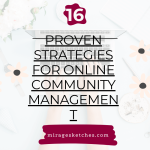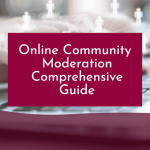Introduction
Building and growing a thriving online community from scratch can feel overwhelming, but it’s one of the best ways to grow a loyal and engaged audience.
A thriving community helps build connections, trust, and lasting relationships with your audience, which in turn boosts your brand or business.
In this guide, we’ll walk through the simple steps to build and grow your online community effectively.
Understanding the Purpose of Your Online Community
Before you start building, you need to know why your community exists.
What is the main purpose of your online community?
Is it to help customers, share knowledge, or connect people with similar interests?
Having a clear purpose helps you attract the right people and keeps your community focused.
For example, a fitness brand may create a community to share workout tips and motivate people to live healthier lives.
Knowing this purpose will guide the type of content and interactions you encourage.
Identifying Your Target Audience
To grow a strong community, you need to know who you are speaking to.
Identify your target audience, these are the people who will benefit from joining your community.
Think about their age, interests, problems, and goals.
The more you understand your audience, the better you can meet their needs.
For example, if you run a parenting blog, your target audience might be new parents looking for advice and support.
When you know who your community is for, you can tailor your content and discussions to them.
Choosing the Right Platform for Your Community
Choosing the best platform to host your community is an important step.
There are several options like Facebook groups, Discord, Slack, or even private forums.
Each platform has its own features, so think about where your audience is most active.
For instance, a business-related community might work well on LinkedIn, while a gaming community might thrive on Discord.
Pick a platform that suits both your needs and your audience’s preferences.
Creating Engaging and Valuable Content
For a community to thrive, you need to provide value.
People join communities to learn, connect, and get something they can’t find elsewhere.
To keep your members engaged, offer content that is helpful, fun, and interactive.
This could include tutorials, Q&A sessions, polls, or even exclusive content that members can’t get anywhere else.
If you run a photography group, for example, share tips, host photo challenges, and invite experts to provide feedback.
Engaging content keeps members coming back and encourages them to participate.
Encouraging Interaction and Participation
A quiet community will struggle to grow, so it’s important to encourage interaction.
Ask questions, start discussions, and create opportunities for members to share their thoughts and experiences.
Gamification, such as badges or points for participation, can also motivate members to engage more.
You could also run live events, polls, or contests to get people excited and talking. The more active your community is, the more it will grow.
Building Relationships with Community Members
People stay in communities where they feel seen and heard.
Building strong relationships with your members is key to your community’s success.
Make sure to respond to comments, answer questions, and show appreciation for your members.
Being approachable and friendly creates a welcoming environment where people feel valued.
For example, if a member shares their story or asks a question, take the time to respond thoughtfully.
This personal connection helps build trust and loyalty.
Moderating and Managing Your Community
As your community grows, you’ll need to manage it well.
Set clear rules and guidelines to ensure respectful and positive interactions.
Having a few moderators can help keep the community safe and enjoyable for everyone.
It’s also important to handle conflicts quickly and fairly to prevent issues from escalating.
For instance, in a support group, you may need to have guidelines about what kind of language or posts are acceptable to ensure that members feel safe and respected.
Analyzing Growth and Adapting Strategies
To ensure your community continues to grow, it’s important to keep an eye on how it’s performing.
Use tools to track your community’s growth, engagement, and feedback.
If something isn’t working, don’t be afraid to change your approach.
Ask your members for feedback on what they like or what they’d like to see more of.
This way, you can keep improving and adapting your community to meet their needs.
Final Thought
Building and growing a thriving online community takes time, but with the right strategies, it can become a valuable asset.
Start small, stay consistent, and watch your community grow!





